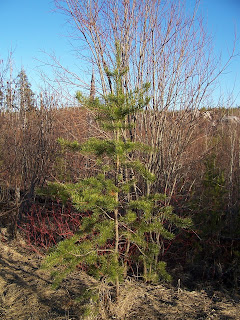 |
| Red Pine (Pinus resinosa) |
 |
| Red Pine Trunk |
 |
| Red Pine Needles |
Spring is continuing to progress on the Gunflint Trail. The ice fully departed Gunflint Lake two days ago, the snow is gone, and there is very little ice left on the other lakes and streams of the area.
We still do not have most our green plants yet, although the pine trees are green throughout the year. There are three types of pines in the area: the Red Pine, Jack Pine, and White Pine.
The Red Pine is our state tree. It is often called the Norway Pine because it reminded some of the early Norwegian settlers of the Norway Spruce. It can be identified by the clusters of 2 long needles, thick flaky bark, and a round cone. The bark is so thick that it can burn for more than an hour in a forest fire, and still survive.
 |
| Jack Pine (Pinus banksiana) |
The Jack Pine also has clusters of 2 needles, although they are shorter than the Red Pine. Its' bark is flaky, but not as thick as the Red Pine. The serotinous cones are tightly sealed until a fire comes along and opens them up (with temperatures of 105 - 200 degrees Fahrenheit. Jack Pine seeds can handle over 1000 degrees Fahrenheit for a couple of seconds and are one of the first species to come back after a fire. The tree to the left was born in the Ham Lake Fire of 2007.
 |
| Jack Pine Needles |
 |
| The seroninous (sealed) cones of a Jack Pine can stay on the tree for decades. |
The White Pine can be identified by the clusters of 5 needles, and elongated cones. Remember that there are five needles in a cluster, and 5 letters in the word white.
The White Pine was the mainstay of the timber industry in the area. It was a preferred tree because it was tall and straight, and floated like a cork. The trees were sent to the lumber mills by floating them down rivers and across lakes (including Lake Superior). A very dangerous job at the time was releasing the log jams on the rivers, but it was safer when the trees floated like corks. When the trees got to the mills, they were used for everything from ship's masts to match sticks.
This whole area was logged at one time. When Teddy Roosevelt brought about the Superior National Forest in 1909, it was basically described as a bunch of rocks and stumps not good for agriculture or much of anything else. The forest has come back nicely in the last 108 years.
 |
| White Pine (Pinus strobus) |
 |
| White Pine Cone |
 |
| White Pine Needles |
The fresh needles of all 3 of these trees can be used to make a healthy tea that is high in vitamins A and C. Simply gather some fresh needles (about 1 tablespoon per cup of water), chop them up, and pour boiled water over the top. Let them steep for 5 - 10 minutes, and enjoy.
The Red Pine and White Pine needle tea tastes pretty similar, and the Jack Pine is slightly different. I've done blind taste tests with people, and the Jack Pine always wins.









No comments:
Post a Comment